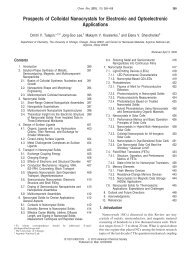FORWARD KINEMATICS: THE DENAVIT-HARTENBERG ...
FORWARD KINEMATICS: THE DENAVIT-HARTENBERG ...
FORWARD KINEMATICS: THE DENAVIT-HARTENBERG ...
You also want an ePaper? Increase the reach of your titles
YUMPU automatically turns print PDFs into web optimized ePapers that Google loves.
72CHAPTER 3. <strong>FORWARD</strong> <strong>KINEMATICS</strong>: <strong>THE</strong> <strong>DENAVIT</strong>-<strong>HARTENBERG</strong> CONVENTION<br />
a hinge and allows a relative rotation about a single axis, and a prismatic<br />
joint permits a linear motion along a single axis, namely an extension or<br />
retraction.) The difference between the two situations is that, in the first<br />
instance, the joint has only a single degree-of-freedom of motion: the angle of<br />
rotation in the case of a revolute joint, and the amount of linear displacement<br />
in the case of a prismatic joint. In contrast, a ball and socket joint has two<br />
degrees-of-freedom. In this book it is assumed throughout that all joints<br />
have only a single degree-of-freedom. Note that the assumption does not<br />
involve any real loss of generality, since joints such as a ball and socket joint<br />
(two degrees-of-freedom) or a spherical wrist (three degrees-of-freedom) can<br />
always be thought of as a succession of single degree-of-freedom joints with<br />
links of length zero in between.<br />
With the assumption that each joint has a single degree-of-freedom, the<br />
action of each joint can be described by a single real number: the angle of<br />
rotation in the case of a revolute joint or the displacement in the case of a<br />
prismatic joint. The objective of forward kinematic analysis is to determine<br />
the cumulative effect of the entire set of joint variables. In this chapter<br />
we will develop a set of conventions that provide a systematic procedure<br />
for performing this analysis. It is, of course, possible to carry out forward<br />
kinematics analysis even without respecting these conventions, as we did<br />
for the two-link planar manipulator example in Chapter 1. However, the<br />
kinematic analysis of an n-link manipulator can be extremely complex and<br />
the conventions introduced below simplify the analysis considerably. Moreover,<br />
they give rise to a universal language with which robot engineers can<br />
communicate.<br />
A robot manipulator with n joints will have n + 1 links, since each joint<br />
connects two links. We number the joints from 1 to n, and we number the<br />
links from 0 to n, starting from the base. By this convention, joint i connects<br />
link i − 1 to link i. We will consider the location of joint i to be fixed with<br />
respect to link i − 1. When joint i is actuated, link i moves. Therefore, link<br />
0 (the first link) is fixed, and does not move when the joints are actuated.<br />
Of course the robot manipulator could itself be mobile (e.g., it could be<br />
mounted on a mobile platform or on an autonomous vehicle), but we will<br />
not consider this case in the present chapter, since it can be handled easily<br />
by slightly extending the techniques presented here.<br />
With the i th joint, we associate a joint variable, denoted by qi. In the<br />
case of a revolute joint, qi is the angle of rotation, and in the case of a
















